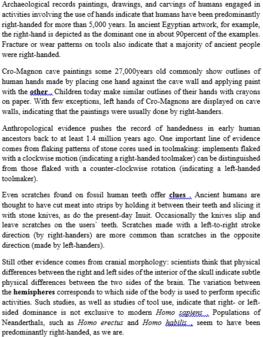Read the following passage and mark the letter A, B, C, or D on your answer sheet to indicate the correct answer to each of the questions from 43 to 50
In the exploration of the linguistic life cycle, it is apparent that it is much more difficult to learn a second language in adulthood than a first language in childhood. Most adults never completely master foreign language, especially in phonology - hence the ubiquitous foreign accent. Their development often "fossilizes" into permanent error patterns that no teaching or correction can do. Of course, there are great individual differences, which depend on effort, attitudes, amount of exposure, quality of teaching and plain talent, but there seems to be a cap for the best adults in the best circumstances.
Many explanations have been advanced for children's superiority: they exploit Motherless (the simplified, repetitive conversation between parents and children), make errors oneself- consciously, are more motivated to communicate, like to conform, are not set in their ways, and have no first language to interfere. But some of these accounts are unlikely, based on what is known about how language acquisition works. Recent evidence is calling these social and motivation explanations into doubt. Holding every other factor constant, a key factor stands out: sheer age.
Systematic evidence comes from the psychologist Elisa Newport and her colleagues. They tested Korean and Chinese-born students at the University of Illinois who had spent at least ten years in the United States. The immigrants were given a list of 276 simple English sentences, half of them containing some grammatical errors. The immigrants who came to the United States between the ages of 3 and 7 performed identically to American bom students. Those who arrived between the ages of 8 and 15 did worse the later they arrived, and those who arrived between 17 and 39 did the worst of all, and showed huge variability unrelated to their age of arrival.
It can be inferred from the passage that "phonology" is the study of the.................. of a language.
A. grammar
B. vocabulary
C. sound system
D. native speakers




Đáp án C
Giải thích: Có thể suy ra từ đoạn văn rẳng “ngữ âm học” là sự nghiên cứu về __________ của một ngôn ngữ.
A. ngữ pháp;
B. từ vựng;
C. hệ thống âm thanh;
D. người bản địa
“Most adults never completely master foreign language, especially in phonology - hence the ubiquitous foreign accent.”
Dich: Hầu hết người lớn không bao giờ hoàn toàn nắm bắt được một ngoại ngữ, đặc biệt về ngữ âm - vì vậy xuất hiện các âm điệu nước ngoài ở mọi nơi.